It looks like you're using an Ad Blocker.
Please white-list or disable AboveTopSecret.com in your ad-blocking tool.
Thank you.
Some features of ATS will be disabled while you continue to use an ad-blocker.
share:
I put some thought into where to put this. It could fit in Fragile Earth for the Environmental side of things, but Al Gore isn't an Environmental
scientist. He's a politician. It is political policy he seeks to change, by leading it..if possible, as opposed to seeking and creating the data which
he tries to present. So I settled on this one for a forum. It surely is madness...but I'll take a moment to explain why.
I won't focus too much on venue, but to note he once commanded far more prestigious ones, where people far more influential and powerful sat with fixed attention to hear him speak. That change is...remarkable. I will note that he's come to basically pointing to what we call "weather" as a crisis in all forms it seems. If it's a disaster ..which history shows happen without any modern changes... he seems to attribute it to climate change. He tops it with a statement as absurd as when he said..and YES he really DID say...he invented the Internet. (Somewhere in my parody/comedy MP3's, I have the audio of that speech..it's a hoot to hear every time)
No.... It's not. The Dust Bowl was a freak of nature and phenomenon only man's ignorance and arrogance could have mixed with to bring about. Farming entire areas of states in the worst ways possible created a condition of top soil where a cyclical drought condition arriving with just some typical open prairie winds were enough to make storms that killed by the static electricity and dust in the air alike.
Some material on the Dust Bowl...with some context to present day. (I had all this already from a dust bowl thread I was in the process of making but never got the chance to finish)..
What it looked like:
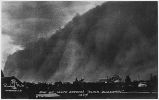
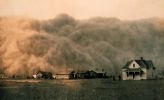
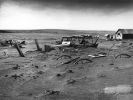
What caused it:

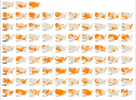
Covered areas indicate drought impact..and sorry everything isn't sourced, but some of this has been sitting in my vault for quite awhile with the notebook to match for sourcing, currently buried somewhere around here.
This is what that would have looked like ...with modern measurements. It was cyclical and still is. It's come before in drought, it will come again and our behavior isn't the cause.
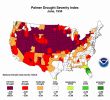
For general interest, this is what the crop report actually did look like back then.

and what conditions have looked like in more recent years...
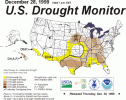 1999
1999
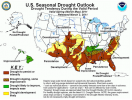 2011
2011
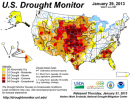 2013
2013
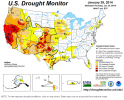 Current - 2014
Current - 2014
It's not the underlying topic of Climate change, as I've come to realize, which is being rejected and rightfully so. It's the over the top political rhetoric and hyperbole, like saying the Dust Bowl is coming back or even could, ..when the man should know the unique conditions which caused it and could never reoccur in modern practices. I think men like Gore have come to do more harm than good to the causes they claim to champion. Primarily because their statements can often be so ignorant and easily proven as being so.
When one fudges the small things, when can they ever be believed on the big stuff? Getting those little things right, matters.
Gore filled a Westin Crown Center ballroom with a 90-minute presentation, using photos and videos to illustrate a litany of floods, wildfires, torrential rains, droughts, dust storms, rising sea levels and increasing world temperatures.
To those attending the Folk Alliance International conference, he noted examples of flooding in locations both remote and closer to home, such as in Manitou Springs, Colo., where high water barreled down mountain highways last year, carrying cars along with it.
I won't focus too much on venue, but to note he once commanded far more prestigious ones, where people far more influential and powerful sat with fixed attention to hear him speak. That change is...remarkable. I will note that he's come to basically pointing to what we call "weather" as a crisis in all forms it seems. If it's a disaster ..which history shows happen without any modern changes... he seems to attribute it to climate change. He tops it with a statement as absurd as when he said..and YES he really DID say...he invented the Internet. (Somewhere in my parody/comedy MP3's, I have the audio of that speech..it's a hoot to hear every time)
Source
“Think about that,” he said. “The Dust Bowl is coming back, quickly, unless we act.”
No.... It's not. The Dust Bowl was a freak of nature and phenomenon only man's ignorance and arrogance could have mixed with to bring about. Farming entire areas of states in the worst ways possible created a condition of top soil where a cyclical drought condition arriving with just some typical open prairie winds were enough to make storms that killed by the static electricity and dust in the air alike.
Some material on the Dust Bowl...with some context to present day. (I had all this already from a dust bowl thread I was in the process of making but never got the chance to finish)..
What it looked like:



What caused it:


Covered areas indicate drought impact..and sorry everything isn't sourced, but some of this has been sitting in my vault for quite awhile with the notebook to match for sourcing, currently buried somewhere around here.
This is what that would have looked like ...with modern measurements. It was cyclical and still is. It's come before in drought, it will come again and our behavior isn't the cause.

For general interest, this is what the crop report actually did look like back then.

and what conditions have looked like in more recent years...
 1999
1999  2011
2011  2013
2013  Current - 2014
Current - 2014 It's not the underlying topic of Climate change, as I've come to realize, which is being rejected and rightfully so. It's the over the top political rhetoric and hyperbole, like saying the Dust Bowl is coming back or even could, ..when the man should know the unique conditions which caused it and could never reoccur in modern practices. I think men like Gore have come to do more harm than good to the causes they claim to champion. Primarily because their statements can often be so ignorant and easily proven as being so.
When one fudges the small things, when can they ever be believed on the big stuff? Getting those little things right, matters.
edit on 23-2-2014 by Wrabbit2000 because: (no reason given)
Well I think the inventor of the interwebs, formerly our next President..Should just focus on politics and leave the science to scientists. What's he
been up to lately anyways?
I mean job wise not peddling his DVD and Doom porn?
I mean job wise not peddling his DVD and Doom porn?
edit on 23-2-2014 by SLAYER69 because: (no reason given)
reply to post by SLAYER69
Well, since you asked..I checked!
He co-founded Generational Investment Management in 2004 and is currently listed as Chairman of the company.
He's also a partner in Kleiner Perkins & Byers which is a venture capitalist firm. Hmm...
Perhaps he's more a businessman now than a politician. Still no environmental scientist though, and I'd sure not brag about history knowledge in his case.
Well, since you asked..I checked!
He co-founded Generational Investment Management in 2004 and is currently listed as Chairman of the company.
He's also a partner in Kleiner Perkins & Byers which is a venture capitalist firm. Hmm...
Perhaps he's more a businessman now than a politician. Still no environmental scientist though, and I'd sure not brag about history knowledge in his case.
If there is going to be a Dust Bowl style of event during this next dry spell, it will take place in the West - California, Nevada, Arizona, states
like that. They're the ones who are over-populated and who have used egregiously poor practices of land and water management when farming and
developing.
The Dust Bowl was caused by the perfect storm of drought and poor farming practices. We learned from it. They'll learn the hard way out West, too, if the dry doesn't reverse.
The Dust Bowl was caused by the perfect storm of drought and poor farming practices. We learned from it. They'll learn the hard way out West, too, if the dry doesn't reverse.
reply to post by Wrabbit2000
Like always Gore takes a few facts and twists them around to serve his current agenda
if we look at this weeks western snowpack reports

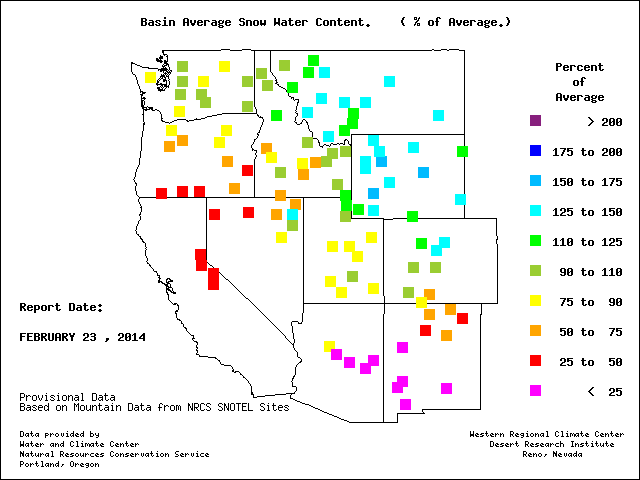

The lower half of the western states is indeed below norms but the northern half is having one our best years in decades and the snow season is far from over
Like always Gore takes a few facts and twists them around to serve his current agenda
if we look at this weeks western snowpack reports



The lower half of the western states is indeed below norms but the northern half is having one our best years in decades and the snow season is far from over
ketsuko
reply to post by HardCorps
How much of that drains through Cali, though?
everything west of this line drains into the Pacific
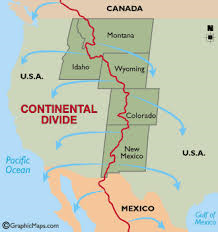
Even a large percent of the Colorado River out flow is redirected down in AZ and sent to LA via the Colorado River Aqueduct.
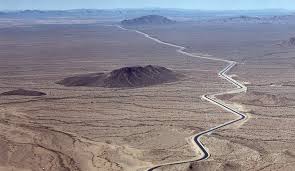
reply to post by Wrabbit2000
Um, folk alliance conference? Has he fallen from grace or what? And why is their conference in the Westin hotel?
Maybe he was just trying to pick up some easy hippies distracted while mourning the loss of Pete Seeger.
Um, folk alliance conference? Has he fallen from grace or what? And why is their conference in the Westin hotel?
Maybe he was just trying to pick up some easy hippies distracted while mourning the loss of Pete Seeger.
reply to post by HardCorps
It still looks like the larger part is going to not help relieve their drought much.
That was my point in asking. There's a lot of snow out there, but I'll bet much of it goes elsewhere. If it was good news that we had so much snowpack that it was going to relieve Cali, there wouldn't so much worry about the Sierra Nevada snowpack, or lack thereof.
It still looks like the larger part is going to not help relieve their drought much.
That was my point in asking. There's a lot of snow out there, but I'll bet much of it goes elsewhere. If it was good news that we had so much snowpack that it was going to relieve Cali, there wouldn't so much worry about the Sierra Nevada snowpack, or lack thereof.
reply to post by Wrabbit2000
Correct me if I am wrong…
I have noticed this subtle shift from calling it "Global Warming" to "Climate Change", no?
Should be easier to justify whatever BS they are running. I mean, since my thermometer isn't actually climbing to unberfore highs…
I can't hardly argue with "Bad Weather".
I will note that he's come to basically pointing to what we call "weather" as a crisis in all forms it seems. If it's a disaster ..which history shows happen without any modern changes… he seems to attribute it to climate change.
Correct me if I am wrong…
I have noticed this subtle shift from calling it "Global Warming" to "Climate Change", no?
Should be easier to justify whatever BS they are running. I mean, since my thermometer isn't actually climbing to unberfore highs…
I can't hardly argue with "Bad Weather".
Those that cast their religion under the guise of Global Climate. . . er. . . Weather, remind me of our primitive ancestors who would hoot and howl at
the setting of the sun, worrying that it might leave them in darkness forever.
It is, in my humble opinion, all political madness. Use of weather to enact political, idealogical change is dishonest and smacks of Snake Oil salesmen.
"Buy my product! It will save the planet and only cost you most of your money!"
It is, in my humble opinion, all political madness. Use of weather to enact political, idealogical change is dishonest and smacks of Snake Oil salesmen.
"Buy my product! It will save the planet and only cost you most of your money!"
reply to post by beezzer
Quite true the 'religion' of global warming.
That some people like myself have dubbed the 'Church of Climatology', and make no mistake it is a religion.
They aren't exactly burning people at the stake yet, but metaphorically they do.
Non believers are the new 'heretics'.
My Gore have mercy on their souls!
Meanwhile the 'rich get richer' with their snake oil 'facts', and push the same old progressive agenda they have for the last 100 years.
Those that cast their religion under the guise of Global Climate. . . e
Quite true the 'religion' of global warming.
That some people like myself have dubbed the 'Church of Climatology', and make no mistake it is a religion.
They aren't exactly burning people at the stake yet, but metaphorically they do.
Non believers are the new 'heretics'.
My Gore have mercy on their souls!
Meanwhile the 'rich get richer' with their snake oil 'facts', and push the same old progressive agenda they have for the last 100 years.
reply to post by Wrabbit2000
By all rights that is where all threads pertaining to 'global warming' truly belong.
It is not about the science. It has never been about the science.
Global warming is just a new face on a century old 'perceived' problem.
Them evil corporations!
Most advocates of 'Global warming' for some odd reason can't admit their cause has been hijacked by pundits.
To push political agendas.
The same agenda anyone paying attention sees crystal clear.
I put some thought into where to put this. It could fit in Fragile Earth for the Environmental side of things, but Al Gore isn't an Environmental scientist. He's a politician
By all rights that is where all threads pertaining to 'global warming' truly belong.
It is not about the science. It has never been about the science.
Global warming is just a new face on a century old 'perceived' problem.
Them evil corporations!
Most advocates of 'Global warming' for some odd reason can't admit their cause has been hijacked by pundits.
To push political agendas.
The same agenda anyone paying attention sees crystal clear.
The MSM has been pushing this "climate change" crap for far too long... the fact that the MSM is championing this idea should give us a clue
about the validity of the claims...
There is "screwy" weather every year, and there always has been...
There is "screwy" weather every year, and there always has been...
I'm curious where the UDSA gets that New England is "below average" as far as water conditions go. As I type more of the snow is melting (and we
have a LOT of it) and I can almost guarantee that the yard will be a muddy mess for months because the ground which never froze this winter can't
handle any more water. If anything we're going to have more water than normal this spring/summer after all of this white evil stuff melts..
reply to post by vkey08
A good portion of that is where the rain gauges are located... for example, when I lived in Tucson, the "official" gauge is at the airport... I lived in the Rincon foothills area (east side of Tucson), and we averaged 2-3 times as much rain in that area as compared to the airport. Many cities further complicate the issue by the "heat islands" that are created by large areas of pavement and urban development. That "heat island" effect has more of an impact than realized... it throws off both temps and precip data, as the effect can "steer" storms away from the urban area. The NOAA has admitted that this is a problem... the data is quite skewed...
A good portion of that is where the rain gauges are located... for example, when I lived in Tucson, the "official" gauge is at the airport... I lived in the Rincon foothills area (east side of Tucson), and we averaged 2-3 times as much rain in that area as compared to the airport. Many cities further complicate the issue by the "heat islands" that are created by large areas of pavement and urban development. That "heat island" effect has more of an impact than realized... it throws off both temps and precip data, as the effect can "steer" storms away from the urban area. The NOAA has admitted that this is a problem... the data is quite skewed...
edit on 23-2-2014 by madmac5150 because: Puppies and kittens! Puppies and kittens!
edit on 23-2-2014 by madmac5150 because: Al
Gore wants to EAT MY BRAIN
reply to post by Wrabbit2000
Hmm. Seems to me it was irrigation that fixed the dustbowl problem, by sucking water out of the Ogallala Aquifer. Problem is, the Ogallala hasn't been replenished and is about sucked dry. Bye bye Breadbasket. Wrote about it here back in 2004.
Texas "Rule of Capture" Fight Heats Up.
Hmm. Seems to me it was irrigation that fixed the dustbowl problem, by sucking water out of the Ogallala Aquifer. Problem is, the Ogallala hasn't been replenished and is about sucked dry. Bye bye Breadbasket. Wrote about it here back in 2004.
Texas "Rule of Capture" Fight Heats Up.
soficrow
reply to post by Wrabbit2000
Hmm. Seems to me it was irrigation that fixed the dustbowl problem, by sucking water out of the Ogallala Aquifer. Problem is, the Ogallala hasn't been replenished and is about sucked dry. Bye bye Breadbasket. Wrote about it here back in 2004.
Texas "Rule of Capture" Fight Heats Up.
Actually, the dust bowl issue was solved more by strategic tree planting, crop rotation and the return of natural grasses... irrigation played a far smaller role...
edit on 23-2-2014 by madmac5150 because: Puppies and kittens! Puppies and kittens!
reply to post by madmac5150
Hmmm.
Hmmm.
On October 18, 2012, the Associated Press reported that “a massive dust storm swirling reddish-brown clouds over northern Oklahoma triggered a multi-vehicle accident along a major interstate…forcing police to shut down the heavily traveled roadway amid near blackout conditions.” Farmers in the region had recently plowed fields to plant winter wheat. The bare soil—desiccated by the relentless drought that smothered nearly two-thirds of the continental United States during the summer and still persists over the Great Plains—was easily lifted by the passing strong winds, darkening skies from southern Nebraska, through Kansas, and into Oklahoma.
.....After World War II, well-drilling and pumping technologies allowed farmers to tap into the Ogallala aquifer, a vast reservoir of water beneath the Plains, stretching from southern South Dakota through the Texas Panhandle. Irrigation expanded, with center-pivot sprinklers creating the green circles overlain on brown squares that are familiar to anyone who has flown over the central United States.
In recent decades irrigation has allowed the traditional Corn Belt to move westward onto drier lands. Kansas, for instance, sometimes called “the Wheat State,” harvesting one-sixth of the U.S. crop, now produces as much corn as it does wheat. The wheat is primarily rainfed, but more than half the corn is irrigated.
As extraction of the underground water has increased, however, water tables have fallen. The depletion is particularly concerning in the Central and Southern Plains where there is virtually no replenishment of the aquifer from rainfall, foreshadowing an end to the use of this finite resource. In the former Dust Bowl states, irrigation had its boom, but in many areas it is beyond its peak. With wells going dry, ....
In the years since the Dustbowl days, soil erosion control methods have improved but irrigation is the major technical adaptation installed to cope with severe drought is irrigation. The Dustbowl film did not really address this and, frankly, the tapping of the Ogallala Aquifer to support agriculture in the American Plains is worthy of another Burns documentary.
Irrigation has long been viewed as the solution to drought problems in the American West.
reply to post by Wrabbit2000
...................and the crowd goes wild................[crickets]
Al is now driving around like the rest of us. His inconvenient truth is that he cant afford to gas up the plane.
...................and the crowd goes wild................[crickets]
Al is now driving around like the rest of us. His inconvenient truth is that he cant afford to gas up the plane.
new topics
-
Only two Navy destroyers currently operational as fleet size hits record low
Military Projects: 4 hours ago -
George Stephanopoulos and ABC agree to pay $15 million to settle Trump defamation suit
Mainstream News: 9 hours ago
top topics
-
George Stephanopoulos and ABC agree to pay $15 million to settle Trump defamation suit
Mainstream News: 9 hours ago, 17 flags -
Light from Space Might Be Travelling Instantaneously
Space Exploration: 17 hours ago, 9 flags -
More Bad News for Labour and Rachel Reeves Stole Christmas from Working Families
Regional Politics: 16 hours ago, 8 flags -
Only two Navy destroyers currently operational as fleet size hits record low
Military Projects: 4 hours ago, 7 flags
active topics
-
-@TH3WH17ERABB17- -Q- ---TIME TO SHOW THE WORLD--- -Part- --44--
Dissecting Disinformation • 3687 • : angelchemuel -
The Mystery Drones and Government Lies
Political Conspiracies • 72 • : tarantulabite1 -
Only two Navy destroyers currently operational as fleet size hits record low
Military Projects • 1 • : alwaysbeenhere2 -
A priest who sexually assaulted a sleeping man on a train has been jailed for 16 months.
Social Issues and Civil Unrest • 30 • : alwaysbeenhere2 -
They Know
Aliens and UFOs • 86 • : ianmoone3 -
George Stephanopoulos and ABC agree to pay $15 million to settle Trump defamation suit
Mainstream News • 11 • : WeMustCare -
President-Elect DONALD TRUMP's 2nd-Term Administration Takes Shape.
Political Ideology • 331 • : WeMustCare -
Nov 2024 - Former President Barack Hussein Obama Has Lost His Aura.
US Political Madness • 15 • : WeMustCare -
Former DNI-Congressman John Ratcliffe says the U.S. Government is Intimidated by UFOs.
Aliens and UFOs • 41 • : WeMustCare -
One out of every 20 Canadians Dies by Euthanasia
Medical Issues & Conspiracies • 23 • : Daughter2v2
